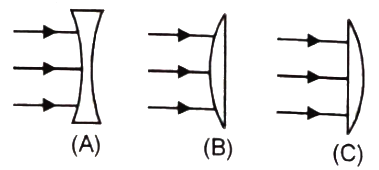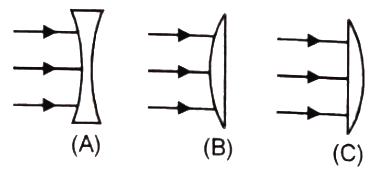A thin lens of focal length 10 cm is cut into two equal halves and is kept as shown in the figure. If an object O is placed at a distance 10 cm from the optical centre of combination, then the distance of the image from the object will be

(1) 5 cm
(2) 7.5 cm
(3) 10 cm
(4) 20 cm
10 cm फोकस दूरी का एक पतला लेंस दो समान हिस्सों में काटा जाता है और आकृति में दिखाए गए अनुसार रखा गया है। यदि वस्तु O को संयोजन के प्रकाशीय केंद्र से 10 cm की दूरी पर रखा जाता है, तो वस्तु से प्रतिबिंब की दूरी होगी-

(1) 5 cm
(2) 7.5 cm
(3) 10 cm
(4) 20 cm


If four convex lenses, given to you have focal lengths , then which of the following combination will you prefer to form a compound microscope?
(1) as objective and as eye-lens
(2) as objective and as eye-lens
(3) as objective and as eye-lens
(4) as objective and as eye-lens
यदि आपको फोकस दूरी के चार उत्तल लेंस दिए गए हैं तो आप निम्नलिखित में से किस संयोजन से आप यौगिक सूक्ष्मदर्शी बनाना पसंद करेंगे?
(1) अभिदृश्यक के रूप में और नेत्र लेंस के रूप में
(2) अभिदृश्यक के रूप में और नेत्र लेंस के रूप में
(3) अभिदृश्यक के रूप में और नेत्र लेंस के रूप में
(4) अभिदृश्यक के रूप में और नेत्र लेंस के रूप में
Three lenses A, B and C are shown in the figure. Lens A is concave lens. B and C are plano-convex lenses. All the lenses have same focal length f. In which case the spherical; aberration is minimum?

1. A
2. B
3. C
4. All of the above
तीन लेंस A, B और C को चित्र में दिखाया गया है। लेंस A अवतल लेंस है। B और C समतल-उत्तल लेंस हैं। सभी लेंसों की समान फोकस दूरी f है। किस स्थिति में गोलीय विपथन न्यूनतम है?

1. A
2. B
3. C
4. उपरोक्त सभी
The angle of incidence for a ray of light at a refracting surface of a prism is 45°. The angle of prism is 60°. If the ray suffers minimum deviation through the prism, the angle of deviation and refracting index of the material of the prism respectively are
1. 30°,
2. 45°,
3. 30°,
4. 45°,
प्रिज़्म के अपवर्तक पृष्ठ पर आपतित प्रकाश-किरण के लिए आपतन कोण 45° है। प्रिज़्म कोण 60° है। यदि प्रिज़्म के माध्यम में किरण न्यूनतम विचलन दर्शाती है, विचलन कोण और प्रिज़्म के पदार्थ का अपवर्तनांक क्रमशः हैं -
1. 30°,
2. 45°,
3. 30°,
4. 45°,
The focal length of a thin convex lens for red and blue light is 0.5m and 0.484m. The dispersive power of the lens is
1. 0.984
2. 0.032
3. 0.484
4. 0.434
लाल और नीले प्रकाश के लिए एक पतले उत्तल लेंस की फोकस दूरी 0.5m और 0.484m है। लेंस की परिक्षेपन क्षमता कितनी है?
1. 0.984
2. 0.032
3. 0.484
4. 0.434
The graph between u and v for a convex mirror is
एक उत्तल दर्पण के लिए u और v के बीच का ग्राफ है:
In an experiment of find the focal length of a concave mirror a graph is drawn between the magnitudes of u and v. The graph looks like

एक अवतल दर्पण की फोकस दूरी ज्ञात करने के एक प्रयोग में, u और v के परिमाणों के मध्य ग्राफ आरेखित किया गया है। ग्राफ कैसा दिखता है?
The refracting angle of a prism is A, and refractive index of the material of the prism is cot(A/2). The angle of minimum deviation is-
1. 180-3A
2. 180-2A
3. 90-A
4. 180+2A
प्रिज्म का अपवर्तक कोण A है और प्रिज्म के पदार्थ का अपवर्तनांक है। न्यूनतम विचलन कोण है-
For a convex lens, the distance of the object is taken on X-axis and the distance of the image is taken on Y-axis, the nature of the graph so obtained is :
(a) Straight line (b) Circle
(c) Parabola (d) Hyperbola
उत्तल लेंस के लिए, वस्तु की दूरी को X- अक्ष पर लिया जाता है और प्रतिबिम्ब की दूरी को Y- अक्ष पर लिया जाता है, इस प्रकार प्राप्त ग्राफ की प्रकृति इस प्रकार है:
(a) सरल रेखा (b) वृत्त
(c) परवलय (d) अतिपरवलय
A point object is moving on the principal axis of a concave mirror of focal length 24
cm towards the mirror. When it is at a distance of 60 cm from the mirror, its velocity is
9cm/sec. What is the velocity of the image at that instant
1. 5cm/sec towards the mirror
2. 4cm/sec towards the mirror
3. 4cm/sec away from the mirror
4. 9cm/sec away from the mirror
एक बिंदु वस्तु 24 cm फोकस दूरी वाले अवतल दर्पण के मुख्य अक्ष पर दर्पण की ओर गतिमान है। जब यह दर्पण से 60 cm की दूरी पर है, इसका वेग 9cm/sec है। उस क्षण पर प्रतिबिंब का वेग क्या है?
1. 5cm/sec दर्पण की ओर
2. 4cm/sec दर्पण की ओर
3. 4cm/sec दर्पण से दूर
4. 9cm/sec दर्पण से दूर







